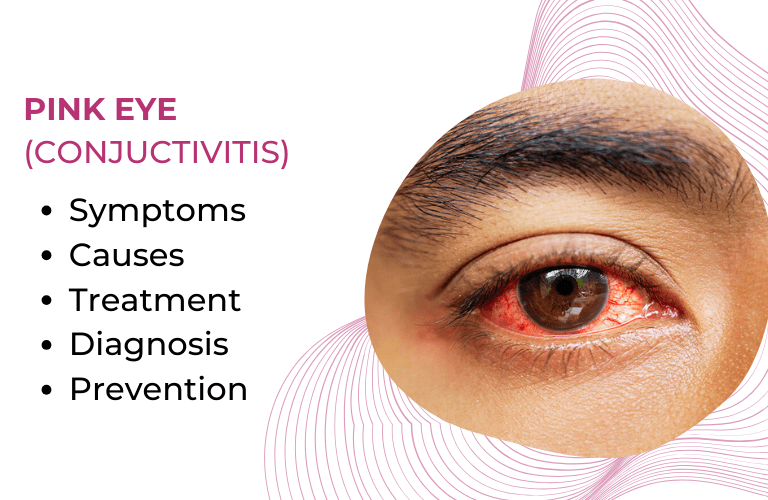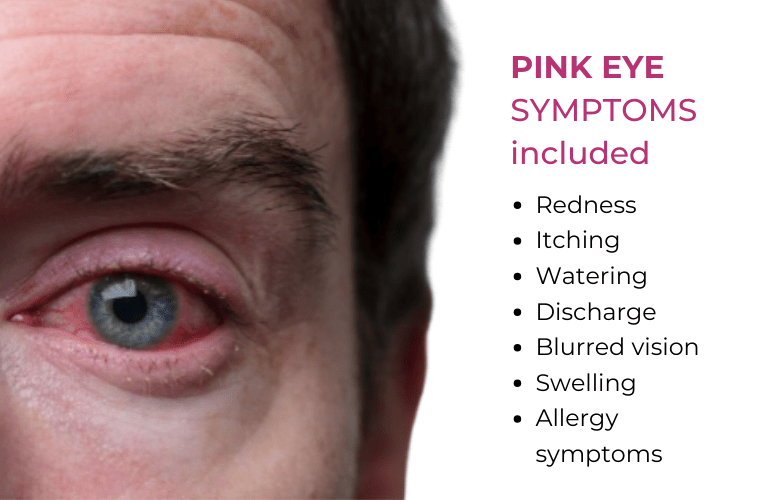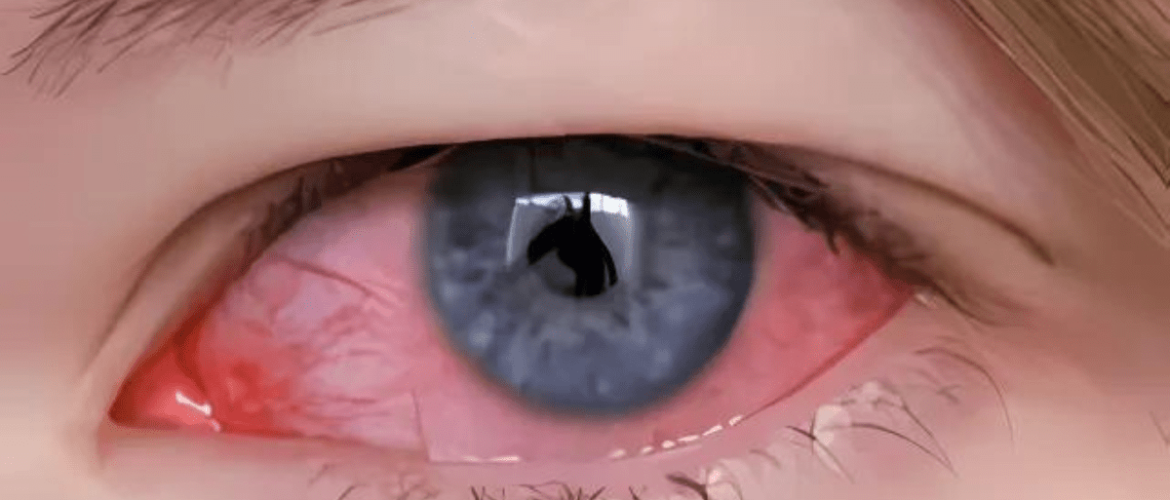Overview of Pink Eye
Conjunctivitis, commonly called pink eye is a common eye problem characterized by inflammation of the conjunctiva – the thin, transparent tissue that covers the front of the eye and lines the inner surface of the eyelids. It can affect all age groups from infants to adults.
The redness caused is irritating but it does not have any impact on your vision. Pink eyes are mostly due to viral infection, but they can also be bacterial, allergic, or sometimes due to closed tear ducts in babies.
Though it is contagious proper precaution and treatment can help you in healing from this eye condition. Following proper treatment can help you to overcome the problem within a few days and you can resume your work immediately.

Causes of Pink Eye
Pink eye or conjunctivitis, can be caused by Various factors, each of which contributes to the varied types of this eye condition. The different factors that contribute to the pink eye are
- Viral Infection:Viral infections, particularly adenoviruses, are one of the most common causes of pink eye. These viruses spread via respiratory droplets or direct contact with contaminated surfaces, causing redness, watery discharge, and eye irritation. Viral conjunctivitis is extremely contagious and can cause cold-like symptoms.
- Bacterial Infection:Bacterial Conjunctivitis is usually caused by bacteria such as Staphylococcus aureus or Streptococcus pneumoniae. It is distinguished by redness of the eyes, thick yellow or green discharge, and crusting of the eyelids. Direct contact with contaminated hands or objects can spread bacterial conjunctivitis.
- Allergic Reactions:Allergic conjunctivitis is caused by an allergy to allergens such as pollen, pet dander, or dust mites. It results in Itching, redness, and watery eyes. Allergic conjunctivitis usually affects both eyes, and it is frequently accompanied by other allergic symptoms such as sneezing and a runny nose.
- Irritants and Foreign Objects:Non-infectious conjunctivitis can be caused by irritants such as smoking, pollution, or chemicals. Furthermore, physical contact with foreign items, such as contact lenses that have not been properly cleaned or fitted, can cause irritation and redness.
Among all types, bacterial and viral conjunctivitis are the most contagious. Some of the common ways of pink eye infection are:
- Direct contact with the infected person’s bodily fluids or through hand and eye contact.
- Bacteria living in a person’s nose or sinus can initiate eye infection.
- Improper hygienic maintenance while using the contact lens or touching the eye with dirty hands.
- School kids are more prone to pink eyes as they come in contact with a large mass of people and don’t practice proper hygiene.

Symptoms of Pink Eyes (Conjunctivitis)
Pink eye or conjunctivitis shows a number of symptoms. Identifying these symptoms can help you in early diagnosis and timely treatment. Some of the prominent symptoms of pink are
- Redness:The white part of the eye starts appearing pink or red due to infection of the conjunctiva, the thin tissue covering the eyeball. Or may appear red due to subconjunctival haemorrhage (collection of blood beneath the conjunctiva).
- Watery Eyes:Excessive tears or watery discharge may occur, resulting in a continual moist feeling in the eye.
- Itching, Irritation, and Pain: A common symptom is persistent itching or a gritty sensation in the eyes along with moderate pain, which often leads to rubbing of the eyes.
- Swelling:Conjunctival and tissue swelling around the eyes can produce puffiness and discomfort.
- Crust Formation:Bacterial pink eye can cause crusts or sticky discharge around the eyelids, especially after sleeping.
- Eye Discharge:Bacterial conjunctivitis can generate a yellow or greenish discharge, which can cause the eyelids to cling together when you wake up.
- Allergy Symptoms:Allergic conjunctivitis may be accompanied by other allergy symptoms such as sneezing, runny nose, or nasal congestion.
Best Treatment for Conjunctivitis
The treatment of conjunctivitis depends on the cause of the infection. Here are some approaches for different types of conjunctivitis:
- Viral Infections:Viral conjunctivitis does not require any treatment. Using a damp-washed cloth can help you feel comfortable. You can use teardrops or artificial tear eye drops to lessen the irritation. Your body can fight the viral infection on its own. But take precautions to contain its spread.
- Bacterial Infections:Antibiotics are used to treat pink eye due to bacterial infection. In addition, frequent use of warm water to clean eyes helps in removing discharge and ease discomfort. Antibiotics can only treat bacterial infections.
- Allergies:It is critical to avoid allergens and irritants. Antihistamine eye drops, available over-the-counter or on prescription, can help alleviate itching and redness. Cold compresses can soothe your eyes.
- Irritants:Avoid going near exposed chemicals or dust. Rinse your eyes thoroughly with water and use some artificial tears or eye drops to reduce itchiness.
It is advisable to visit the doctor if you have any symptoms of pink eye. As if it is found to be communicable you can spread it to other persons in your house and workplace.
At MM Joshi Eye Hospital, we have a team of specialized doctors who can help you get the right diagnosis and offer the best treatment for Pink eye if required. If you face any of the symptoms defined above it is recommended to visit an ophthalmologist and get your checkup done as early as possible.
How to Avoid the Spreadness of Pink Eyes
To prevent the spread of pink eye, also known as conjunctivitis, it’s important to follow these hygiene measures:
- Wash your hands frequently with soap and water, especially after touching your eyes or face.
- Avoid frequent touching of eyes and rubbing them.
- Use clean towels, washcloths, and bed linens, and avoid sharing them with others.
- Throw the used tissues and napkins after cleaning the eyes or nose.
- If you are diagnosed with pink eye avoid going to school, the workplace, or any public place.
- Stay at home and take proper rest until you are properly cured.
- Follow the advice and use medicines prescribed by an eye specialist.
- If you use contact lenses, clean them properly as recommended by the doctor and avoid their usage during eye infections.
- Avoid using eye makeup till the infection lasts.
Conclusion
Conjunctivitis or pink eye is a general eye infection that can be cured with proper treatment and maintaining hygiene. If you see any of such symptoms mentioned above you must consult a doctor and take proper rest.
FAQs
What is the main cause of pink eye?
The main causes of pink are viral infection, bacterial infection, allergens, or any foreign object that causes itching, irritation, and redness in the eyes.
Can pink eye be cured?
The pink eye can take up to 7 days to be cured with or without treatment. However, seeing a doctor early can help you alleviate your symptoms faster & prevent the rapid spread of infection.
Will the pink eye go away by itself?
Viral pink eyes can heal by itself in a week. Proper rest and hygiene are advisable for the pink eye treatment. Whereas bacterial pink eye requires treatment with antibiotics prescribed by the doctor.
Can pink eye heal in a day?
Viral pink can take 3-7 days to heal while bacterial infection can take up to 7 days to heal. However, in some cases, the healing period can last up to 10 days
What is a pink eye look like?
Pink eyes or conjunctivitis look like red or pink in color. This is due to the redness in the conjunctiva, the clear membrane covering the white part of the eye, and the inner surface of the eyelids
Is pink eye Itchy?
Yes, Pink eyes are itchy. The other symptoms are redness, pain, swelling, and watery discharge.
Is pink eye wet or dry?
Pink eye is usually wet. Most of the people infected with pink eye face watery discharge after infection.
Can you get pink eyes by looking into someone's eye?
There is a common misconception that eye flu can spread just by looking into someone’s eye. However, this isn’t true. Simply stated, you must touch someone or something to become infected.

No comments yet.